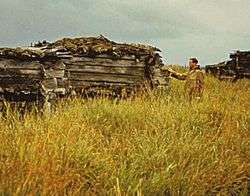Old Savonoski Site
The Old Savonoski Site is the former site of a native village in Lake and Peninsula Borough, Alaska, that was buried by ash in the June 1912 eruption of the Novarupta Volcano. The site is located near the confluence of the Savonoski and Ukak Rivers, and is within the bounds of the Katmai National Park and Preserve.[3] The site was visited by archaeologists in 1953, who identified a number of surviving elements, including fifteen barabaras, or semi-subterranean dwellings.[4]
Old Savonoski Site | |
Alaska Heritage Resources Survey
| |
 1940 image of food caches at site | |
| Location | Address restricted[1], Katmai National Park and Preserve |
|---|---|
| Nearest city | King Salmon |
| Area | 52 acres (21 ha) |
| NRHP reference No. | 78000344[2] |
| AHRS No. | XMK-001 |
| Added to NRHP | June 23, 1978 |
The site was listed on the National Register of Historic Places in 1978.[2]
See also
References
- Federal and state laws and practices restrict general public access to information regarding the specific location of this resource. In some cases, this is to protect archeological sites from vandalism, while in other cases it is restricted at the request of the owner. See: Knoerl, John; Miller, Diane; Shrimpton, Rebecca H. (1990), Guidelines for Restricting Information about Historic and Prehistoric Resources, National Register Bulletin, National Park Service, U.S. Department of the Interior, OCLC 20706997.
- "National Register Information System". National Register of Historic Places. National Park Service. July 9, 2010.
- "The Story of a House". National Park Service. Retrieved 2014-02-28.
- "Building in an Ashen Land: Historic Resource Study: Chapter 3: Russian and Early American Influence". National Park Service. Retrieved 2014-12-02.
This article is issued from Wikipedia. The text is licensed under Creative Commons - Attribution - Sharealike. Additional terms may apply for the media files.

.svg.png)